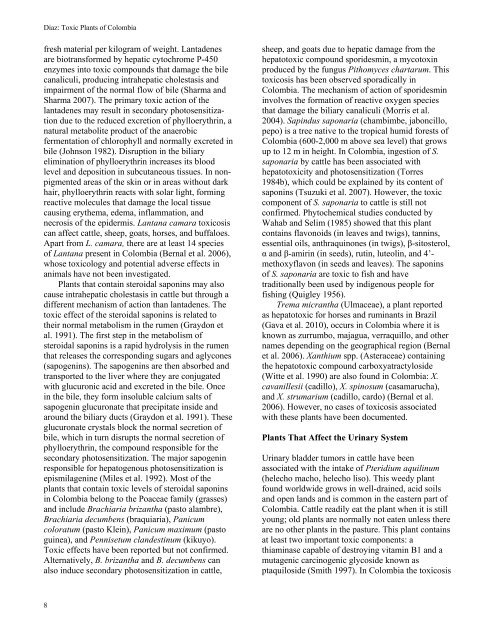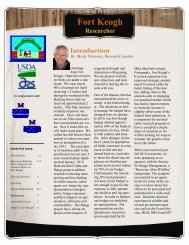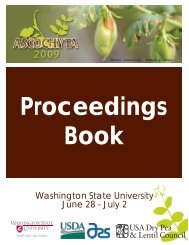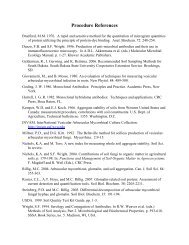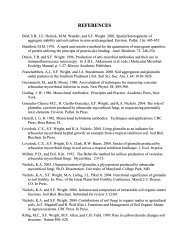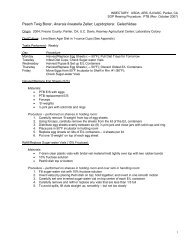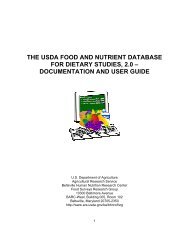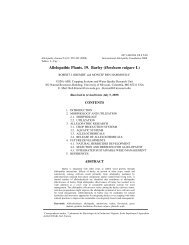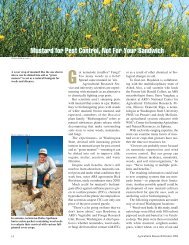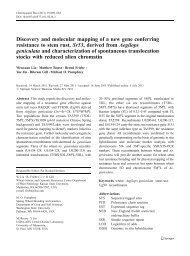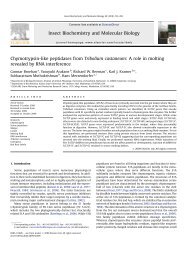International Journal of Poisonous Plant Research - Agricultural ...
International Journal of Poisonous Plant Research - Agricultural ...
International Journal of Poisonous Plant Research - Agricultural ...
Create successful ePaper yourself
Turn your PDF publications into a flip-book with our unique Google optimized e-Paper software.
Diaz: Toxic <strong>Plant</strong>s <strong>of</strong> Colombia<br />
fresh material per kilogram <strong>of</strong> weight. Lantadenes<br />
are biotransformed by hepatic cytochrome P-450<br />
enzymes into toxic compounds that damage the bile<br />
canaliculi, producing intrahepatic cholestasis and<br />
impairment <strong>of</strong> the normal flow <strong>of</strong> bile (Sharma and<br />
Sharma 2007). The primary toxic action <strong>of</strong> the<br />
lantadenes may result in secondary photosensitization<br />
due to the reduced excretion <strong>of</strong> phylloerythrin, a<br />
natural metabolite product <strong>of</strong> the anaerobic<br />
fermentation <strong>of</strong> chlorophyll and normally excreted in<br />
bile (Johnson 1982). Disruption in the biliary<br />
elimination <strong>of</strong> phylloerythrin increases its blood<br />
level and deposition in subcutaneous tissues. In nonpigmented<br />
areas <strong>of</strong> the skin or in areas without dark<br />
hair, phylloerythrin reacts with solar light, forming<br />
reactive molecules that damage the local tissue<br />
causing erythema, edema, inflammation, and<br />
necrosis <strong>of</strong> the epidermis. Lantana camara toxicosis<br />
can affect cattle, sheep, goats, horses, and buffaloes.<br />
Apart from L. camara, there are at least 14 species<br />
<strong>of</strong> Lantana present in Colombia (Bernal et al. 2006),<br />
whose toxicology and potential adverse effects in<br />
animals have not been investigated.<br />
<strong>Plant</strong>s that contain steroidal saponins may also<br />
cause intrahepatic cholestasis in cattle but through a<br />
different mechanism <strong>of</strong> action than lantadenes. The<br />
toxic effect <strong>of</strong> the steroidal saponins is related to<br />
their normal metabolism in the rumen (Graydon et<br />
al. 1991). The first step in the metabolism <strong>of</strong><br />
steroidal saponins is a rapid hydrolysis in the rumen<br />
that releases the corresponding sugars and aglycones<br />
(sapogenins). The sapogenins are then absorbed and<br />
transported to the liver where they are conjugated<br />
with glucuronic acid and excreted in the bile. Once<br />
in the bile, they form insoluble calcium salts <strong>of</strong><br />
sapogenin glucuronate that precipitate inside and<br />
around the biliary ducts (Graydon et al. 1991). These<br />
glucuronate crystals block the normal secretion <strong>of</strong><br />
bile, which in turn disrupts the normal secretion <strong>of</strong><br />
phylloerythrin, the compound responsible for the<br />
secondary photosensitization. The major sapogenin<br />
responsible for hepatogenous photosensitization is<br />
epismilagenine (Miles et al. 1992). Most <strong>of</strong> the<br />
plants that contain toxic levels <strong>of</strong> steroidal saponins<br />
in Colombia belong to the Poaceae family (grasses)<br />
and include Brachiaria brizantha (pasto alambre),<br />
Brachiaria decumbens (braquiaria), Panicum<br />
coloratum (pasto Klein), Panicum maximum (pasto<br />
guinea), and Pennisetum clandestinum (kikuyo).<br />
Toxic effects have been reported but not confirmed.<br />
Alternatively, B. brizantha and B. decumbens can<br />
also induce secondary photosensitization in cattle,<br />
8<br />
sheep, and goats due to hepatic damage from the<br />
hepatotoxic compound sporidesmin, a mycotoxin<br />
produced by the fungus Pithomyces chartarum. This<br />
toxicosis has been observed sporadically in<br />
Colombia. The mechanism <strong>of</strong> action <strong>of</strong> sporidesmin<br />
involves the formation <strong>of</strong> reactive oxygen species<br />
that damage the biliary canaliculi (Morris et al.<br />
2004). Sapindus saponaria (chambimbe, jaboncillo,<br />
pepo) is a tree native to the tropical humid forests <strong>of</strong><br />
Colombia (600-2,000 m above sea level) that grows<br />
up to 12 m in height. In Colombia, ingestion <strong>of</strong> S.<br />
saponaria by cattle has been associated with<br />
hepatotoxicity and photosensitization (Torres<br />
1984b), which could be explained by its content <strong>of</strong><br />
saponins (Tsuzuki et al. 2007). However, the toxic<br />
component <strong>of</strong> S. saponaria to cattle is still not<br />
confirmed. Phytochemical studies conducted by<br />
Wahab and Selim (1985) showed that this plant<br />
contains flavonoids (in leaves and twigs), tannins,<br />
essential oils, anthraquinones (in twigs), β-sitosterol,<br />
α and β-amirin (in seeds), rutin, luteolin, and 4’methoxyflavon<br />
(in seeds and leaves). The saponins<br />
<strong>of</strong> S. saponaria are toxic to fish and have<br />
traditionally been used by indigenous people for<br />
fishing (Quigley 1956).<br />
Trema micrantha (Ulmaceae), a plant reported<br />
as hepatotoxic for horses and ruminants in Brazil<br />
(Gava et al. 2010), occurs in Colombia where it is<br />
known as zurrumbo, majagua, verraquillo, and other<br />
names depending on the geographical region (Bernal<br />
et al. 2006). Xanthium spp. (Asteraceae) containing<br />
the hepatotoxic compound carboxyatractyloside<br />
(Witte et al. 1990) are also found in Colombia: X.<br />
cavanillesii (cadillo), X. spinosum (casamarucha),<br />
and X. strumarium (cadillo, cardo) (Bernal et al.<br />
2006). However, no cases <strong>of</strong> toxicosis associated<br />
with these plants have been documented.<br />
<strong>Plant</strong>s That Affect the Urinary System<br />
Urinary bladder tumors in cattle have been<br />
associated with the intake <strong>of</strong> Pteridium aquilinum<br />
(helecho macho, helecho liso). This weedy plant<br />
found worldwide grows in well-drained, acid soils<br />
and open lands and is common in the eastern part <strong>of</strong><br />
Colombia. Cattle readily eat the plant when it is still<br />
young; old plants are normally not eaten unless there<br />
are no other plants in the pasture. This plant contains<br />
at least two important toxic components: a<br />
thiaminase capable <strong>of</strong> destroying vitamin B1 and a<br />
mutagenic carcinogenic glycoside known as<br />
ptaquiloside (Smith 1997). In Colombia the toxicosis


